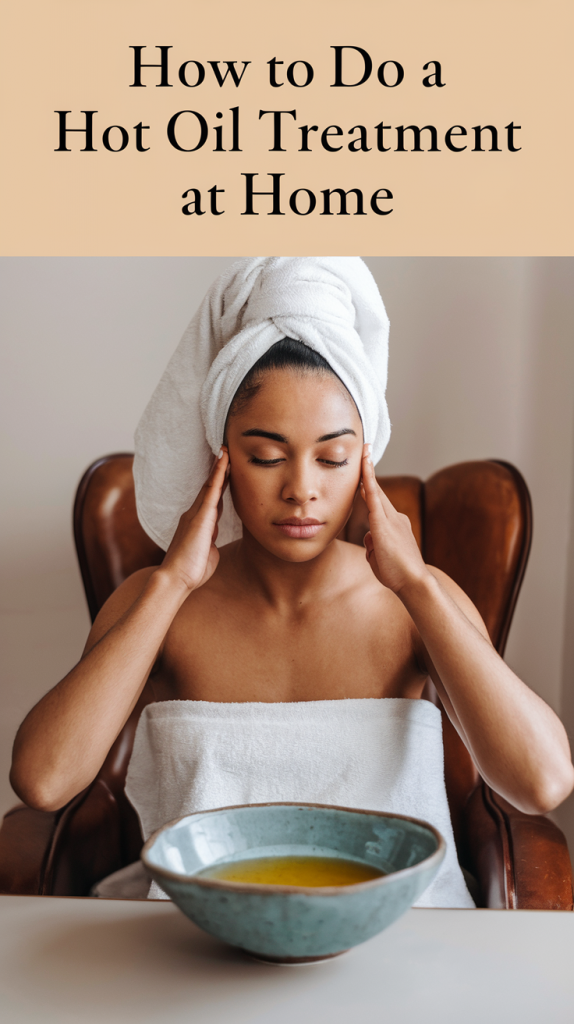Hot Oil Treatment for Natural Hair: The Ultimate Guide
Hot oil treatments have stood the test of time as one of the most effective remedies for revitalizing natural hair. Whether you’re battling dryness, breakage, or just looking for a way to enhance your hair’s natural luster, this guide has you covered. Based on experience and expert insights, I’ll walk you through everything you need to know about hot oil treatments, ensuring you can confidently include this nourishing practice in your routine.

What Is a Hot Oil Treatment?
A hot oil treatment is a deep conditioning technique where warmed natural oils are applied to the scalp and hair to deliver intense hydration and nourishment. The heat helps the oils penetrate the hair shaft and scalp more effectively, making this treatment especially beneficial for natural hair, which often leans toward dryness.
- What It Does:
- Moisturizes hair deeply by sealing in hydration.
- Strengthens hair strands, reducing breakage and split ends.
- Enhances shine and smoothness.
- Improves scalp health by alleviating dryness and itchiness.
- Why It’s Perfect for Natural Hair:
- Natural hair, especially type 3 and type 4 curls, tends to lose moisture quickly.
- Coily textures benefit from the improved elasticity and reduced shrinkage hot oil treatments provide.
Benefits of Hot Oil Treatments
The advantages of hot oil treatments extend beyond simple hydration. They’re a holistic approach to improving your hair’s overall health:
General Benefits
- Moisture Retention: Hot oil treatments lock in moisture by smoothing the hair cuticle.
- Hair Strength: Oils like coconut and olive reduce protein loss, fortifying hair.
- Scalp Health: Massaging the scalp with oil improves circulation and addresses dandruff.
- Enhanced Shine: Treating the hair cuticle creates a smoother surface that reflects light.
Hair-Type Specific Benefits
| Hair Type | Specific Benefits |
|---|---|
| 4C Hair | Reduces shrinkage and improves manageability. |
| 3A-3C Hair | Controls frizz and adds a silky finish. |
| Fine Hair | Lightweight oils like grapeseed or argan provide hydration without weighing down strands. |
Choosing the Right Oils
Not all oils are created equal. The best oils for hot oil treatments depend on your hair’s needs. Here’s a quick guide:
| Oil Type | Key Benefits | Best For |
| Coconut Oil | Reduces protein loss, strengthens hair | Dry, damaged hair |
| Olive Oil | Deep conditioning, improves elasticity | Coarse, brittle hair |
| Avocado Oil | Rich in vitamins A, E, and B5 for moisture | Dry, high-porosity hair |
| Jojoba Oil | Balances scalp’s natural oils, lightweight | Oily or fine hair |
| Castor Oil | Promotes hair growth and thickening | Thin or sparse hair |
| Grapeseed Oil | Lightweight, adds shine and locks in moisture | Fine, oily hair |
| Argan Oil | Tames frizz, boosts elasticity | Frizzy, dull hair |
DIY Oil Blends
Try these oil combinations tailored to your needs:
| Purpose | Oil Combination |
| For Dry Hair | Coconut oil + avocado oil + lavender essential oil. |
| For Growth | Castor oil + olive oil + peppermint essential oil. |
| For Scalp Care | Tea tree oil + jojoba oil + grapeseed oil. |
How to Do a Hot Oil Treatment at Home
Follow this step-by-step process to get the most out of your hot oil treatment:
| Step | Description |
| Prepare the Oil | Choose your oil or mix and warm it in a bowl of hot water. Ensure it’s warm, not hot. |
| Cleanse Your Hair | Start with clean, damp hair to allow the oil to penetrate effectively. |
| Application | Divide hair into sections, massage oil into the scalp, and work through the lengths, focusing on the ends. |
| Processing | Cover hair with a plastic cap or warm towel. Leave on for 20-30 minutes or sit under a hooded dryer for deeper penetration. |
| Rinse and Finish | Rinse thoroughly with lukewarm water and follow up with shampoo and conditioner if needed. |
Pre- and Post-Treatment Tips
- Before Treatment:
- Detangle hair to ensure even application.
- Gently exfoliate your scalp with a brush or a DIY sugar scrub.
- After Treatment:
- Use a satin scarf or pillowcase to maintain moisture overnight.
- Avoid heavy styling for a day to let the treatment fully settle.
Common Mistakes to Avoid
- Overheating the oil: Always test the temperature on your wrist first.
- Skipping the scalp: Focusing only on hair strands can miss out on key benefits.
- Overloading fine hair: Use lighter oils like grapeseed to prevent greasiness.
FAQs
1. Can hot oil treatments promote hair growth?
They indirectly support growth by improving scalp health and reducing breakage.
2. Should I apply the oil to wet or dry hair?
Apply to clean, damp hair for optimal absorption.
3. Can I use hot oil treatments on color-treated hair?
Yes, but choose gentle oils like avocado or argan to prevent stripping color.
4. How often should I do hot oil treatments?
- Dry/Damaged Hair: Weekly.
- Normal Hair: Bi-weekly.
- Oily Hair: Monthly.
5. Can I leave the oil in overnight?
Yes, but protect your bedding with a cap or towel.
6. How do I know if an oil is suitable for me?
Start with a patch test to rule out allergies and adjust based on your hair’s needs.
Conclusion
Hot oil treatments are a powerful addition to any natural hair care routine. By understanding the benefits, choosing the right oils, and following proper techniques, you can unlock healthier, stronger, and more vibrant hair. Have you tried a hot oil treatment before? Share your experience or ask questions in the comments below—I’d love to hear from you!


